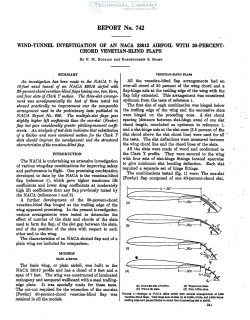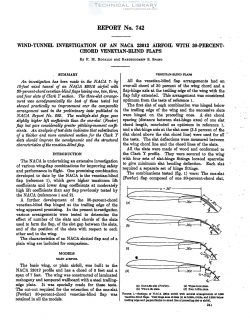naca-report-742

- Version
- 191 Downloads
- 782.83 KB File Size
- 1 File Count
- August 30, 2016 Create Date
- August 30, 2016 Last Updated
National Advisory Committee for Aeronautics, Report - Wind Tunnel Investigation of an NACA 23012 Airfoil with 30% Chord Venetian Blind Flaps

An investigation has been made in the NACA 7'- by
10 Foot wind tunnel of an NACfA 23012 airfoil with
30-percent—chord venetian-blind flaps having one, two, three,
and four slots of Clark Y section. The three-slat arrange-
ment was aerodynamically the best of 'those tested but
showed practically no improrement over the comparable
arrangement used in the preliminary tests published in
NACA Report No. 689.; The multiple-slat flaps gate
slightly higher lift coeficients than the cue-slat (Fowler)
flap but gore considerably greater pitching-moment coefi-
cients. An. analysis of test data indicates that substitution
of a'thicker and more cambered section for the Clark .17
slots should improre the aerodynamic and the structural
characteristics of the reaction-blind flap.
The NACA is undertaking an extensive investigation
of various wing-flap combinations for improving safety
and performance in flight. One promising combination
developed to date by the NACA. is the venetian-blind
flap (reference 1), which gave higher maximum lift
coeficients and lower drag coefiicients at moderately
high lift coefficients than any flap previously tested by
the NACA (references 1 and 2). ’
A further development of the 30-percent-chord
venetian-blind flap hinged at the trailing edge of the
'wing appeared promising. In the present investigation
various arrangements were tested to determine the
efiect of number of the slats and chords of the slats
used to form the flap, of the slot gap between the slate,
and of the position of the slats with respect to each
other and to the wing.
The characteristics of an NACA slotted flap and of a
plain wing are included for comparison.
The basic Wing, or plain airfoil, was built to the
NACA 23012 profile and has a chord of 3 feet and a
span of 7 feet. The wing was constructed of laminated
mahogany and tempered wallboard with a steel trailing-
edge plate. It was specially made for these tests.
The cut-out required for the retraction of the one-slat
(Fowler) 30-percent-chord venetian-blind flap was
retained in all the models.
| File | Action |
|---|---|
| naca-report-742 Wind Tunnel Investigation of an NACA 23012 Airfoil with 30% Chord Venetian Blind Flaps.pdf | Download |

Comment On This Post